Comprehensive Guide to Rainproof Patio Covers
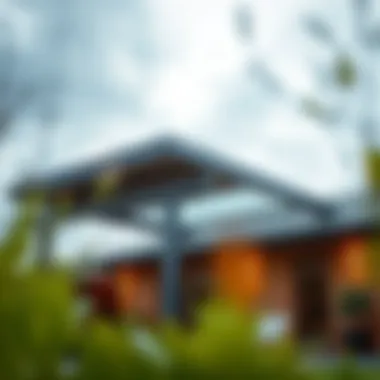
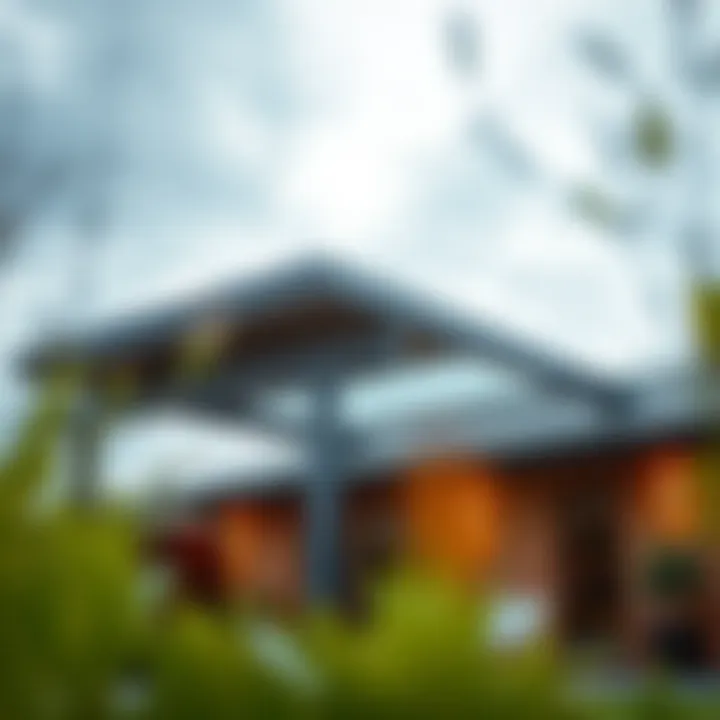
Intro
As outdoor living spaces continue to gain popularity, rainproof patio covers have emerged as a pivotal element for enhancing these areas. Homeowners are recognizing the value of creating versatile retreats that can be enjoyed through various weather conditions. This article embarks on a comprehensive exploration of rainproof patio covers, breaking down their significance, design options, and practical considerations. From understanding material choices to identifying current design trends, we aim to equip readers with the knowledge needed to transform their backyards into true havens, regardless of the weather outside.
Furniture Design Trends
Current Styles and Aesthetics
When it comes to selecting patio furniture, trends are increasingly leaning toward minimalist and contemporary designs. Natural wood finishes paired with sleek metal structures offer a harmonious blend that appeals to the eyes without overwhelming the space. Moreover, rattan and wicker materials are all the rage lately. They provide a casual, inviting look while being surprisingly durable and rain-resistant.
"Design is thinking made visual." – Saul Bass
This quote resonates perfectly when discussing outdoor aesthetics. Homeowners are not just looking for functional furniture; they desire pieces that express personal style while fitting seamlessly into their rainproof arrangements. Bohemian vibes, with soft cushions and eclectic accessories, are making waves. On the other hand, Scandinavian designs, known for their clean lines and neutral colors, continue to hold their ground.
Color Palettes and Materials
The choice of color plays a vital role in defining the overall feel of the outdoor area. Neutral tones—think beige, grey and soft browns—are popular choices for a tranquil ambiance. These tones create a beautiful contrast against vibrant green landscapes. On the flip side, bolder colors—like navy blue or forest green—can evoke sophistication and elegance, especially when accented with bright accessories.
As for the materials, aluminum is rising to the top due to its lightweight, rust-resistant qualities. Additionally, the sustainable choice of recycled metals is becoming increasingly favored, appealing to eco-conscious consumers. Meanwhile, high-quality polycarbonate panels are favored for their durability and ability to withstand heavy rain without compromising the beauty of the space.
Buying Guides
Essential Considerations When Purchasing
When contemplating the purchase of a rainproof patio cover, there are several factors to bear in mind:
- Size and dimension: Make sure the cover complements the scale of the patio area.
- Material selection: Understand the pros and cons of different materials to find what fits best.
- Design compatibility: Choose a style that enhances the existing decor of your home.
- Installation requirements: Consider whether you’ll tackle installation yourself or hire professionals.
- Budget constraints: Establish a clear budget allocation for materials and labor.
Top Recommendations for Different Budgets
Whether you are looking to make a small investment or you have a more substantial budget in mind, there are options in every price range:
- Affordable options: Polypropylene covers offer basic protection at a lower cost.
- Mid-range picks: Aluminum frames with fabric awnings provide an attractive blend of style and functionality.
- Luxury selections: Custom-built wooden structures with glass panels present a stunningly elegant approach but come at a premium.
By keeping these considerations in mind, homeowners can navigate the array of options successfully, leading to informed decisions that enhance their outdoor lifestyles while staying dry during those rainy days.
For further readings on outdoor living spaces and home improvement ideas, check resources like Wikipedia and Britannica.
If you're looking for community insights on rainproof patio covers, visit Reddit for personal experiences and tips shared by homeowners.
Understanding Rainproof Patio Covers
Rainproof patio covers can dramatically impact how one experiences outdoor spaces, especially in regions prone to rain. Understanding these structures is vital not just for homeowners looking to protect their patios but also for designers and DIY enthusiasts keen on enhancing outdoor areas. The importance lies in the variety of options available that can cater to personal style, functionality, and regional weather conditions.
Definition and Purpose
At its core, a rainproof patio cover is a structure designed to provide shelter against rain, allowing individuals to utilize their patios or outdoor spaces regardless of the weather. These covers come in various designs and materials and can range from something simple like a retractable awning to more permanent structures like permeable roofs or solid canopies. The purpose transcends mere rain protection; they serve as eye-catching centerpieces while also functioning as extensions of living spaces. Homeowners enjoy sitting outside even in drizzling weather, which creates opportunities for gatherings, relaxation, or even outdoor kitchens.
Benefits of Rainproof Patio Covers
The advantages of rainproof patio covers are plenty:
- Extended Usage: They allow year-round use of outdoor areas, making them perfect for barbeques during rainy summer days or hosting friends over for game night under the stars.
- Enhanced Aesthetic Appeal: A well-designed patio cover can elevate the look of a home, providing a polished finish to outdoor spaces.
- Protection for Furnishings: Furnishings placed under a rainproof cover, such as outdoor sofas or tables, suffer less from wear caused by rainy weather.
- Potential Energy Savings: Some designs can provide shade, potentially lowering air conditioning costs during hot months.
- Increased Property Value: Patio covers may boost home value. It shows prospective buyers a well-thought-out outdoor space ready for enjoyment.
Common Misconceptions
Despite their benefits, misconceptions about rainproof patio covers hinder some from considering them seriously:
- Too Complicated to Install: Many homeowners believe that installing a patio cover requires extensive construction knowledge. In reality, many kits are available for DIY enthusiasts or professionals can easily handle installations.
- Only for Certain Climates: While beneficial in wet areas, rainproof patio covers can serve various climates, offering shade in sunny regions. They can also feature drainage systems to manage heavy downpours.
- Lack of Variety in Designs: There's a prevalent notion that patio covers are only available in outdated, basic designs. However, a wide range of modern, stylish options exist that cater to virtually every preference.
The essence of understanding rainproof patio covers is recognizing their inherent value to transform outdoor living into an enjoyable experience regardless of the weather.
By analyzing these dimensions, one can appreciate the multifaceted role of rainproof patio covers. They are not just practical solutions but essential components that enhance the livability of outdoor spaces.
Materials for Rainproof Patio Covers
When it comes to rainproof patio covers, the choice of materials can make or break your outdoor experience. The right material not only ensures functionality but also contributes to the aesthetics of your space. As you explore options, understanding the characteristics, durability, and maintenance requirements of various materials becomes essential. This knowledge empowers homeowners, designers, and DIY enthusiasts to make informed decisions that enhance both comfort and style.
Metal Options
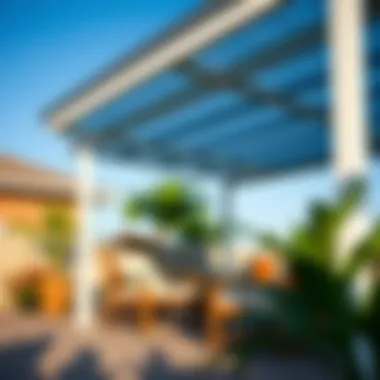

Metal patio covers have carved a niche for themselves in the realm of outdoor structures. Varieties like aluminum and steel are particularly favored for their robustness and longevity. For instance, aluminum is lightweight yet sturdy, resisting rust and corrosion better than many other options. It requires minimal upkeep, making it a preferred choice for busy homeowners.
On the flip side, steel offers exceptional strength to withstand heavy loads and harsh weather. Many regional climates benefit from the durability that steel brings—a factor that can't be overlooked if you're considering a patio cover in areas prone to heavy snowfall or strong storms.
- Pros of Metal Options:
- Cons of Metal Options:
- Long-lasting and durable
- Minimal maintenance required
- Stylish and contemporary look
- Heat conduction can make it uncomfortable without shade
- Prone to scratching and denting if not treated properly
Wood as a Choice
Wood evokes a warm, natural aesthetic that many homeowners find appealing. Choices like cedar and redwood are especially popular due to their resistance to decay and insects. A well-crafted wooden patio cover can blend seamlessly with landscape designs, enriching the beauty of your outdoor living space. However, wood does necessitate ongoing care—it needs to be stained or sealed regularly to fend off rot and other weather-related issues.
That said, the look of wood can often outweigh the maintenance burden for many individuals.
- Pros of Wood Options:
- Cons of Wood Options:
- Timeless appeal and aesthetics
- Excellent insulator against heat
- Environmentally sustainable if sourced responsibly
- Requires regular maintenance to prolong lifespan
- Can be vulnerable to pests and decay
Synthetic Materials
For those seeking a low-maintenance alternative without sacrificing aesthetics, synthetic materials like vinyl or composite can be worthwhile options. These materials emulate the appearance of wood without the issues—like rot or constant upkeep—that can come with natural timber. Vinyl covers are particularly resistant to fading, and their lightweight nature makes installation straightforward.
Similarly, composite materials, which blend wood fibers with recycled plastics, provide that sought-after wood look while being durable and easy to maintain. This fusion results in products that are resistant to weather extremes and look great for years.
- Pros of Synthetic Materials:
- Cons of Synthetic Materials:
- Low maintenance and durability
- Weather-resistant and long-lasting
- Eco-friendly options available
- Can be less authentic in appearance compared to natural materials
- Usually comes with a higher upfront cost
Design Considerations for Materials
When selecting the right material for your rainproof patio cover, several design considerations come into play. Think about how the material complements your existing architecture. Does your home carry a rustic charm or a modern vibe? Additionally, consider the intended use of the space. Will it serve as an outdoor entertaining area, or is it more about creating an inviting personal retreat?
Don’t forget about local climate and seasonal changes. For example, if you live in a region that experiences extreme heat, you may opt for materials with natural insulation properties. Conversely, if heavy rains are a concern, your choice of a more solid metal might be warranted.
"Choosing the right material is not just about aesthetics; it's about durability, maintenance, and how well it integrates with your lifestyle."
Designing Your Rainproof Patio Cover
Designing a rainproof patio cover involves more than just slapping together some materials and calling it a day. This process is vital for those looking to enhance their outdoor living spaces while ensuring protection against unpredictable weather elements. Careful consideration of various aspects ensures that the patio cover not only serves a functional purpose but also becomes a stylish addition to the property.
There are several important elements to consider when planning your patio cover:
- Functionality: The primary aim is to keep you and your guests dry during unexpected rain showers. A well-designed cover shouldn’t just shield but also maintain airflow, preventing heat build-up beneath.
- Aesthetics: The patio cover should complement your home’s architecture rather than clash with it. A solution that meshes well with the existing design will enhance the overall appeal.
- Durability: Selecting the right materials and construction techniques ensures that your patio cover can withstand the elements over time, providing a long-lasting solution.
Architectural Styles
When it comes to architectural styles, the choices are numerous. Each style can dramatically change the overall look of the space. Here are some examples of popular styles:
- Modern: Clean lines, minimalistic design, and often made from materials like aluminum or glass, a modern patio cover provides a sleek and chic aesthetic that fits well with contemporary homes.
- Traditional: Featuring ornate details and wooden structures, traditional styles draw on historical designs, offering a classic appeal that some homeowners find charming and inviting.
- Mediterranean: This style includes archways and tile roofs, often inspired by Spanish or Italian architecture, which adds a cozy, old-world charm to outdoor areas.
Choosing the right architectural style is critical. It not only reflects personal taste but also ensures that your patio cover aligns with the overall environment of your home.
Custom vs. Pre-Made Solutions
When considering your options, you'll typically face a choice between custom-built and pre-made solutions. Each has its merits and drawbacks, and understanding them can help in making the right decision:
- Custom Solutions: Tailoring a cover to your specific needs and preferences can yield a unique result. This means every measurement, every material selection, can reflect your vision. However, it also can come with a higher price tag and longer waiting periods for construction.
- Pre-Made Solutions: These are often more affordable and quicker to install, ideal for homeowners wanting an instant solution. However, they may come with limited options in terms of sizes and styles, which could affect how well they suit your space.
In many cases, weighing upfront costs against long-term satisfaction can assist in deciding between these two tracks.
Color and Finish Choices
The colors and finishes you choose can express your style and can dramatically alter the ambiance of your outdoor area. Consider the following options:

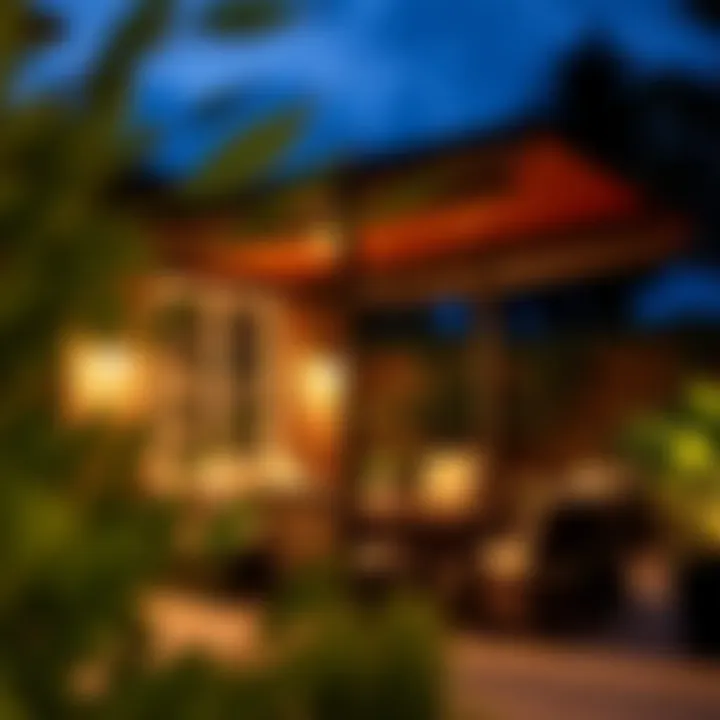
- Neutral Tones: Colors like beige, gray, or white tend to match lots of different architectures and styles of landscaping. They can create a calming atmosphere.
- Bold Hues: For an eye-catching statement, consider brighter colors, especially if your home’s exterior allows for a lively touch.
- Natural Finishes: Going for wood-stains or finishes that mimic natural materials can help the structure blend seamlessly with the surroundings.
Ultimately, selecting the correct color and finish not only expresses your style but can also contribute to the longevity of the materials used, especially in outdoor environments where sun and moisture can impose harsh conditions.
"Your outdoor space is an extension of your home; treating it with care ensures it serves you well through all seasons."
By paying attention to these design details, you’ll not only create a rainproof patio cover that meets your functional needs but also enhances the overall aesthetic of your outdoor space.
Installation of Rainproof Patio Covers
Installing a rainproof patio cover is a pivotal step in enhancing the versatility and comfort of your outdoor space. It’s not just about aesthetics; proper installation influences durability, maintenance, and effectiveness in weathering the elements. This section dives into various methods of installation, weighing the pros and cons of tackling the project yourself versus bringing in professionals, while also addressing the financial aspects that come into play.
DIY Installation Process
For the handy homeowner, the DIY approach can be both rewarding and cost-effective. The first step involves planning: measure your patio area carefully, considering the dimensions and any obstructions. It’s crucial to choose a day with clear weather for the installation to avoid complications. Most kits come with detailed instructions, making the installation process more straightforward.
Key advantages of DIY include:
- Cost savings: You save on labor costs, which can often be a significant portion of the total expense.
- Customization: You can modify features to your liking without adhering to a predetermined design by professionals.
- Sense of accomplishment: There’s a unique satisfaction in completing a project with your own hands.
However, be wary of potential drawbacks:
- Time-consuming: This can take longer than expected, especially if you're not extremely experienced.
- Skill requirement: If you run into difficulties, you might find yourself in over your head.
Hiring Professionals
For those who prefer a less hands-on approach or have complex requirements, hiring professionals could be the sensible choice. Skilled contractors offer expertise that can lead to a well-executed installation. They usually have a better grasp of the local regulations and can ensure that the cover is installed to withstand local weather conditions.
Benefits of hiring pros include:
- Quality assurance: Professionals bring experience that can result in a more durable and reliable installation.
- Saves time: You won’t need to dedicate your personal time to the task.
- Advice and consultation: They often provide suggestions on what design and materials might suit your needs best.
Despite these advantages, hiring professionals comes at a price. It is essential to vet contractors thoroughly, ensuring that you find someone reliable and knowledgeable in the field.
Cost Factors to Consider
Understanding the components of the overall costs involved in installing a rainproof patio cover can help you make informed decisions.
Material Costs
Material costs vary significantly based on the type of cover you choose. Wood, metal, or synthetic options each have their own price points and longevity considerations. For instance, aluminum may provide a longer life span but comes with higher upfront costs. Balancing budget and quality is essential; a cheaper material may not last long enough to justify its initial expense.
Labor Costs
When discussing labor costs, several factors come into play including the complexity of your project and your geographic location. It’s commonly seen that skilled labor might command a premium, but the investment pays off in terms of durability and a proper finish. Always acquire multiple quotes and check references to get the best deal.
Additional Features
While you might be content with a basic rainproof patio cover, consider the various options available for additional features. Integrated lighting, heating systems, or retractable designs add both functionality and comfort. Though they increase installation costs, the enhanced user experience can justify the expense if they meet your lifestyle needs.
"The savvy homeowner knows that investing in quality installation often pays dividends in both enjoyment and longevity of their outdoor improvements."
Maintaining Rainproof Patio Covers
When investing in a rainproof patio cover, maintaining it regularly is critical for multiple reasons. First off, just like any investment in your home, you want to protect and prolong its lifespan. Proper maintenance doesn’t just keep your patio cover looking sharp, but it also ensures it continues to function effectively, allowing you to enjoy your outdoor space rain or shine. A neglected patio cover can lead to unforeseen issues that might end up costing you more in repairs or replacements than a simple maintenance routine.
Regular Maintenance Tips
Establishing a regular maintenance schedule is one of the best ways to keep your rainproof patio cover in mint condition. Here are some practical tips:
- Clean Regularly: Dirt and debris can accumulate and cause wear over time. A simple wash-down with mild soap and water followed by a good rinse can do wonders.
- Inspect for Damage: Routinely check for any signs of wear or damage, such as rust in metal covers or cracks in wood. Catching these early can prevent bigger issues.
- Check Seals and Joints: If your patio cover includes joints or seals, make sure to inspect them for wear. If you spot any gaps or loose areas, address them promptly to maintain waterproof integrity.
- Trim Nearby Vegetation: If trees or shrubs are nearby, you may want to trim them back to prevent branches from damaging the cover or dropping debris that can clog drainage areas.
- Apply Protective Coatings: Depending on the material, consider applying protective treatments, like sealants for wood or rust-proofing agents for metal, to enhance durability.
Common Issues and Solutions
Even with regular maintenance, issues may arise. Knowing how to address these can save you a ton of headaches down the line. Here are a few common problems you might face and suggested solutions:
- Mold and Mildew Build-up: If moisture collects on the cover, mold can become a problem, particularly in humid climates. Regular cleaning and using a mild bleach solution can help.
- Rust on Metal Frames: This is a common issue with metal patio covers, especially in coastal areas. If you notice rust, sand it down and apply a rust-inhibiting primer followed by a fresh coat of paint.
- Warping of Wooden Covers: Excessive exposure to moisture can cause wood to warp. When this happens, replace affected boards and treat the wood with a quality water-repellent.
- Clogged Gutters and Drains: If your cover has an integrated drainage system, ensure it is free of debris to prevent overflow, leading to leaks.
"An ounce of prevention is worth a pound of cure." Regular maintenance of your patio cover can save you from larger repairs and replacements down the road.
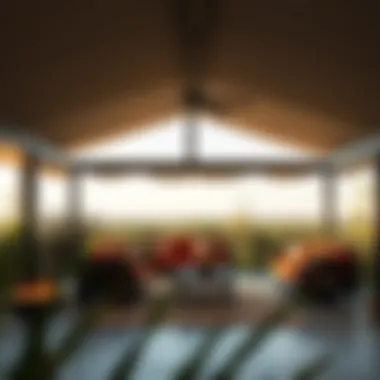
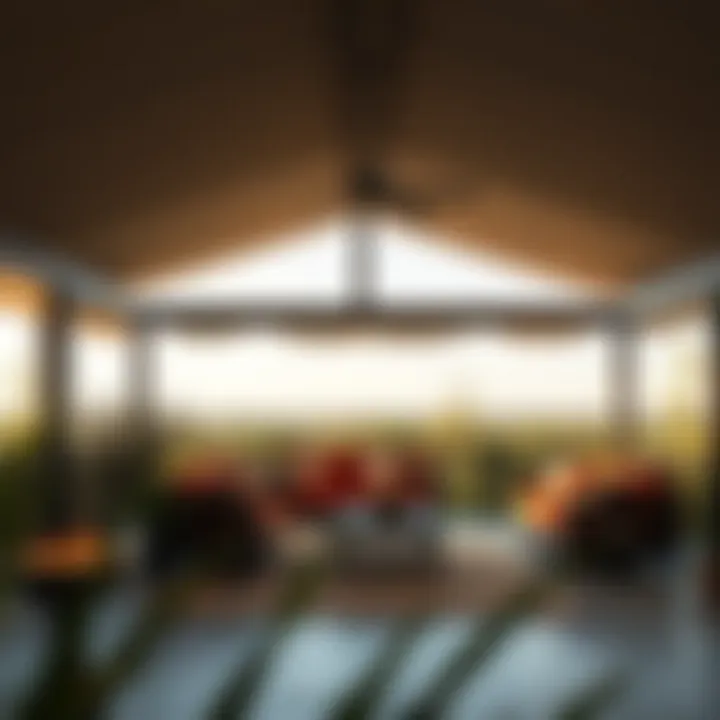
By employing these practices and being proactive, you can ensure that your rainproof patio cover remains a cherished part of your home, enhancing your outdoor experiences today and for years to come.
For more valuable insights, check out resources like Wikipedia and Britannica.
Trends in Rainproof Patio Covers
As outdoor living continues to evolve, staying up-to-date with the latest trends in rainproof patio covers is a must for anyone looking to enhance their space. The designs available have become an essential element not just for protection against the rain, but also for maximising the enjoyment of outdoor areas. Homeowners are often intrigued by how updates in design and technology can elevate the overall experience of their patio spaces.
Sustainable Designs
Sustainability is more than a buzzword; it is a growing expectation among consumers. Rainproof patio covers are increasingly being crafted with eco-friendly materials, which presents homeowners options that are not only durable but also gentle on the planet. Using reclaimed wood, for instance, allows for a rustic appeal while minimizing environmental impact.
Additionally, rainwater harvesting systems integrated into patio covers can collect runoff for garden irrigation. This characteristic not only conserves water but also reduces utility costs. A good example is a slanted roof design that channels rainwater into a barrel or planter, combining functionality with eco-conscience.
Sustainable choices don't merely contribute to environmental preservation; they resonate with a lifestyle that balances aesthetics and responsibility.
Integration of Technology
Technology's role in outdoor designs has been a game-changer. Today's rainproof patio covers benefit from features that make them more functional and enjoyable year-round. More folks are looking for ways to pair practicality with the latest advances.
Smart Features
Smart features in patio covers can significantly enhance user experience. With the integration of sensors that detect rainfall, these systems can automatically retract or extend, offering top-notch convenience. Imagine not having to rush outside to close up your patio while it begins to rain. The built-in smart technology often links up with smartphones, where users can control the cover remotely.
This convenience is a popular selling point — who wouldn't want to manage their outdoor space from the comfort of their couch? A noteworthy trait of these smart systems is the ability to program them for specific weather forecasts. They can save a homeowner time and effort, ensuring protection for anyone looking to entertain outdoor. However, one drawback might be the initial investment; smart technology usually comes at a higher upfront cost.
Lighting Options
Another trend making waves is the incorporation of lighting within patio cover designs. Integrated LED lighting can extend the usability of outdoor spaces into the evening hours, allowing more time to enjoy everything that the patio offers. These lights can be controlled via mobile apps or voice commands, adding an extra layer of convenience.
What's appealing about these lighting solutions is their versatility. Homeowners can adjust brightness or switch colors depending on the mood they want to set, from a cozy ambiance to vibrant gatherings. However, it’s crucial to consider the potential need for additional electrical setups, which could raise the overall cost and complexity of installation.
Case Studies: Successful Rainproof Patio Cover Installations
Understanding the real-world impact of rainproof patio covers is key for homeowners and designers alike. These case studies not only showcase the aesthetic appeal of such installations but also highlight the versatility and functionality that these structures can bring to both residential and commercial properties. Let’s delve into specific projects that exemplify the innovative use of rainproof patio covers, illustrating their benefits and considerations in a practical context.
Residential Projects
Homeowners often seek outdoor spaces that can be utilized rain or shine. Consider the example of a picturesque residence nestled in the Pacific Northwest. Here, the homeowners opted for a stylish aluminum rainproof patio cover, seamlessly integrating it into their existing outdoor area. The sleek, modern design not only protects their outdoor furniture but also allows them to enjoy barbecues and family gatherings despite unpredictable weather.
The installation was fairly straightforward, aided by the lightweight properties of aluminum, which made it easy to work with. Additionally, the reflective surface of the cover helped keep the outdoor area cooler during the sun’s hot peaks, while sheltering it from the rain. After just a few months, the family reported an increase in outdoor activities and gatherings, as the patio now provided a year-round space for entertainment.
Key takeaways from this project include:
- Aesthetic Integration: Blends well with modern architecture, enhancing overall beauty.
- Functionality: Transform a potentially unusable outdoor area into a vibrant, usable space.
- Durability: Aluminum is resistant to rust and corrosion, ensuring longevity.
"A rainproof patio cover can transform mere outdoor space into a true extension of the home, enhancing lifestyle and livability."
Commercial Applications
In the commercial realm, a local café decided to enhance its outdoor seating area with a wooden rainproof patio cover. The structure was designed not only to offer shelter from the rain for patrons but also to enhance the café’s rustic charm, making it attractive to onlookers. The café owner noted a 30% increase in seating turnover during the rainy season as people felt more comfortable sitting outside.
The choice of wood rather than metal created a warm and inviting atmosphere, which aligned perfectly with the café's branding. This choice required careful maintenance, such as periodic sealing and staining, but the visual impact was undeniably worth the effort. Furthermore, the cover allowed for the installation of ambient lighting that created a cozy experience in the evenings.
This case presents several considerations:
- Brand Alignment: Aligning the cover’s material and design with the overall branding can enhance customer experience.
- Increased Revenue: More seating leads to more customers, demonstrating a direct financial benefit.
- Maintenance Needs: Wooden structures require regular upkeep, so plan accordingly to avoid deterioration.
By examining these case studies, it becomes clear that rainproof patio covers serve various purposes, from uplifting the residential experience to driving commercial success. The correct choice of materials and designs tailored to specific environments can profoundly influence how effectively these projects fulfill their intended roles.
Finale: The Future of Rainproof Patio Covers
As the way we utilize outdoor spaces continues to evolve, rainproof patio covers are poised to play a pivotal role in enhancing our living environments. These structures not only provide shelter but serve as extensions of our homes, enabling homeowners to make the most of their outdoor areas throughout the year.
Evolving Outdoor Spaces
The transformation of outdoor spaces reflects changing lifestyle trends and architectural innovations. Homeowners increasingly seek seamless transitions between indoor and outdoor living. Rainproof patio covers make these connections more tangible by offering versatile spaces that are enjoyable, regardless of the weather. From family gatherings under a cozy canopy to serene evenings spent reading, these covers facilitate a wide range of activities.
Moreover, with the rise of urban gardening and eco-friendly initiatives, rainproof covers enable efficient water management. Homeowners can collect runoff for irrigation, thus promoting sustainability while maintaining an aesthetically pleasing environment.
Making Informed Choices
When selecting rainproof patio covers, informed decisions are essential. Differences in material, design, and installation can heavily influence the functionality and aesthetic appeal of these structures. Homeowners should take into account their specific needs and preferences as they explore options. Factors such as climate, maintenance requirements, and budget are critical in this decision-making process.
Educating oneself about the options can prevent the common pitfall of hasty purchases that lack suitability for one's unique situation. For instance, the durability of metal versus traditional wooden covers could directly affect longevity, while aesthetic considerations can significantly impact the overall feel of the property.
“The right patio cover not only protects from rain but enhances the entire outdoor experience.”















